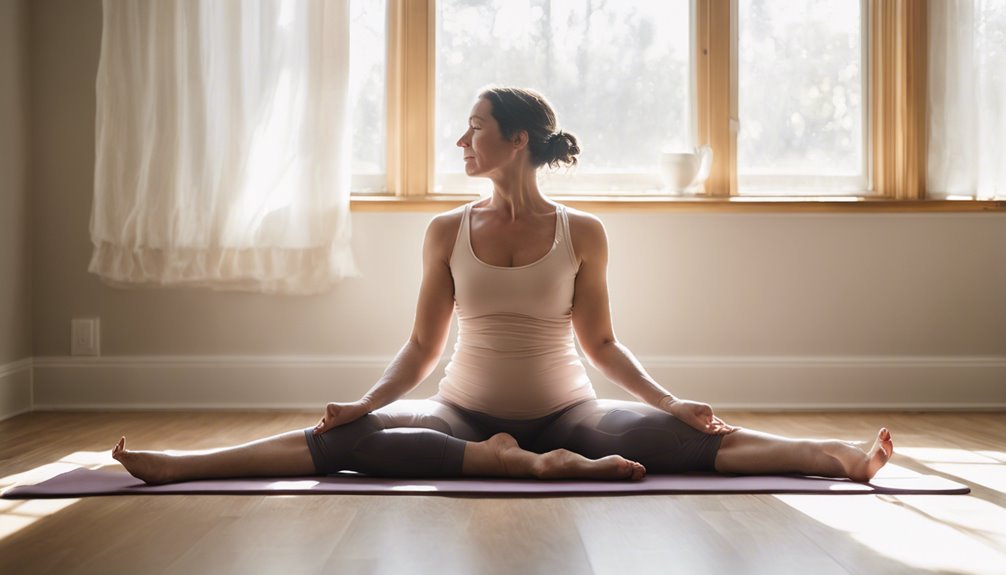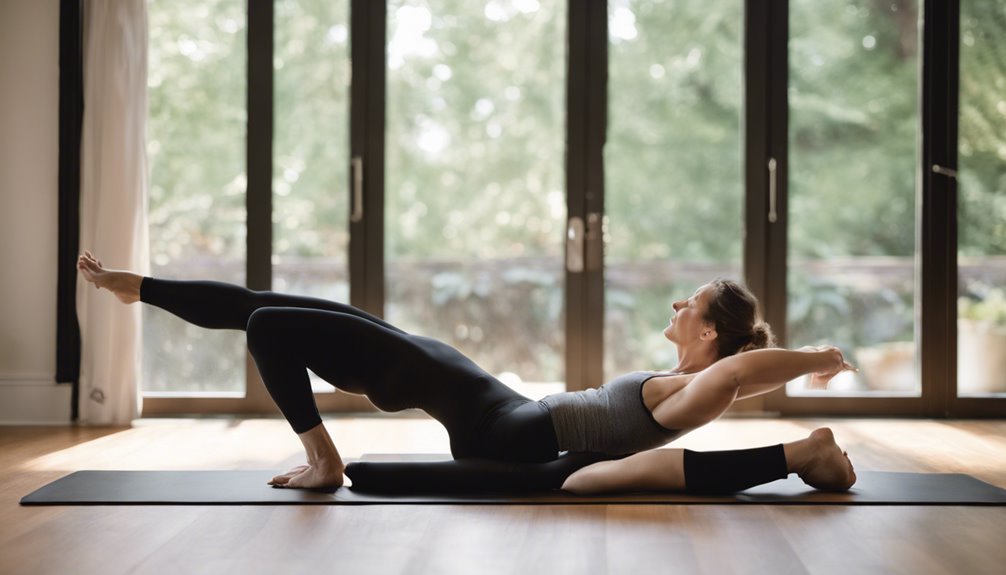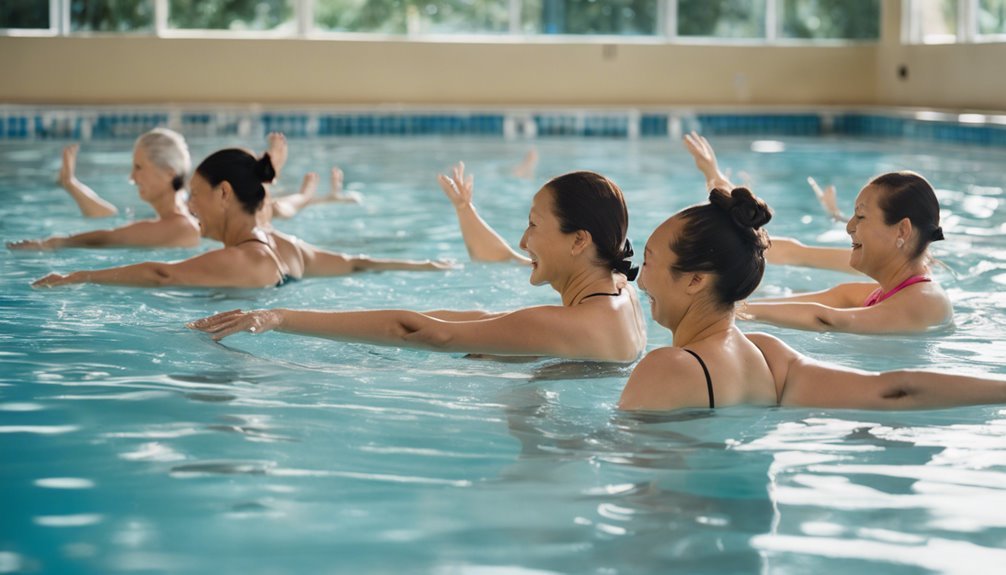Imagine you're six months postpartum and you've just started incorporating yoga stretches into your morning routine to regain the flexibility you enjoyed before pregnancy. While it's common to feel stiffness and a lack of mobility initially, focusing on gentle, targeted stretches can significantly improve your range of motion over time. You'll want to explore which movements offer the best results and how frequently you should engage in them to feel the benefits. Let's discuss further how these small changes can not only enhance your physical health but also positively impact your overall well-being during this transformative period.
Key Takeaways
- Start with gentle stretching exercises, focusing on areas like the lower back and shoulders to ease tension.
- Incorporate yoga practices three times a week to enhance flexibility and promote relaxation.
- Engage in Pilates to strengthen core muscles, starting with basic pelvic tilts and gradually adding more complex exercises.
- Maintain a balanced diet rich in proteins and omega-3s to support muscle recovery and reduce inflammation.
- Set progressive, realistic goals, beginning with simple stretches and gradually increasing the intensity and range of exercises.
Understanding Postpartum Body Changes
While your body has undergone significant changes during pregnancy, it's important to understand how these changes can affect your postpartum recovery. Your journey through motherhood is both remarkable and demanding, and the transformation your body endures is no small part of that.
After childbirth, you might notice that your abdominal muscles have stretched, and your skin might feel looser. This is perfectly normal and part of your body's natural response to making space for your growing baby.
Additionally, hormonal fluctuations continue to affect your body post-delivery. These hormones that helped you during pregnancy are now shifting back, and this can impact your physical health in several ways, including your skin elasticity and joint stability.
It's vital to approach your recovery with patience and understanding, giving your body the time it needs to heal and gradually return to its pre-pregnancy state.
To support your body through this transition, focus on gentle, restorative exercises and proper nutrition. Hydration and a balanced diet rich in vitamins and proteins can significantly enhance your recovery process.
Importance of Postnatal Doctor Visits
Scheduling your postnatal doctor visits is crucial for monitoring your recovery and ensuring your health is on track after childbirth.
These check-ups are vital not only for your physical healing but also for addressing any concerns you might've as you navigate your new role as a mother.
Remember, taking care of yourself is the first step in being able to care for your baby effectively.
Here are some key reasons why postnatal check-ups are essential:
- Health Assessment: Your doctor can monitor your physical recovery, check cesarean section wounds or perineal cuts, and ensure that your uterus is shrinking back to its pre-pregnancy size.
- Mental Health Screening: It's common to experience mood swings or feelings of anxiety postpartum. A healthcare provider can discuss your mental state and provide resources or referrals if needed.
- Guidance on Recovery Milestones: Learn what signs of progress to look for and what might be a red flag indicating a need for further medical attention.
- Family Planning Advice: Discuss future contraception options and timing for expanding your family, if desired.
Be proactive and schedule these appointments.
They're a cornerstone in your journey to full recovery and adjusting to motherhood.
Starting With Gentle Stretching

After your postnatal check-ups confirm that you're healing well, it's an excellent time to start reintroducing physical activity into your routine with gentle stretching.
Begin with easy post baby stretches that gently engage your muscles and joints. These movements aren't only beneficial for your physical recovery but also offer a moment of peace in your busy life as a new mom.
Focus first on areas that need attention, such as your lower back and shoulders. A simple stretch to try is the pelvic tilt, which strengthens your abdominal muscles and eases back pain.
Lie on your back with your knees bent and feet flat on the floor. Slowly flatten your lower back against the floor by tightening your abdominal muscles and tilting your pelvis upwards. Hold for a few seconds, then relax. Repeat this several times, breathing deeply to maximize the stretch.
Incorporate neck rolls and shoulder shrugs to relieve tension. These gentle movements help restore flexibility and can be done several times throughout the day.
Incorporating Yoga Practices
As you become more comfortable with gentle stretching, it's beneficial to incorporate yoga into your post-baby fitness regime. Yoga not only enhances flexibility but also improves your overall well-being, making it a perfect addition to your recovery journey.
Yoga offers a variety of styles, each with unique benefits. You might start with something gentle like Hatha or Iyengar, which focus on slow movements and alignment. As you gain strength and confidence, you could explore more dynamic styles like Vinyasa or Ashtanga.
Here's how you can integrate yoga effectively:
- Choose the Right Style: Match the yoga style to your current fitness level and comfort.
- Focus on Breathing: Incorporate breathing techniques such as Pranayama to help relax your mind and body.
- Set a Routine: Consistency is key. Aim to practice yoga at least three times a week.
- Listen to Your Body: Always be mindful of how your body feels during and after sessions to avoid any strain.
Yoga isn't just physical exercise; it's a way to restore your body and cater to your mental health. Embrace each session as an opportunity to nurture yourself, enhancing your ability to care for others.
Utilizing Pilates for Core Strength

Moving beyond yoga, incorporating Pilates into your post-baby workout regimen can significantly boost your core strength. Pilates focuses on precision and control, with a strong emphasis on core engagement. This is crucial for you, especially after childbirth, as it helps to rebuild the abdominal muscles and improve overall stability.
Begin with basic Pilates principles: alignment, centering, concentration, control, precision, breath, and flow. Each principle plays a critical role in maximizing the effectiveness of your movements.
Start by mastering the pelvic tilt, a fundamental exercise that targets the lower abdomen. Lie on your back with knees bent, feet flat on the floor. Slowly engage your pelvic muscles to tilt your pelvis upward, holding the lift for a few seconds before gently lowering back down.
As you progress, integrate more complex exercises such as the single leg stretch or the criss-cross to promote further core strength and endurance. Remember, it's not about the number of repetitions, but the quality of each movement.
You'll find that with consistent practice, Pilates not only strengthens your core but also enhances your mind-body connection, helping you feel more centered and empowered in your role as a new mom.
Safe Use of Exercise Equipment
Exploring the world of exercise equipment can significantly enhance your post-pregnancy fitness routine, but safety must always be your top priority.
As you work to serve your body's needs and regain your flexibility, here's how you can safely use some common equipment.
- Resistance Bands: Start with lower resistance levels and gradually increase as your strength improves. Ensure the band is securely anchored to avoid snapping back.
- Stability Balls: Choose a ball that matches your height. When sitting, your knees should be at a right angle. Use the ball for balance exercises, but always ensure it's on a non-slip surface.
- Weight Machines: Adjust the seat and weights according to your current fitness level. It's better to start with lighter weights and increase gradually.
- Treadmills: Begin with a slow walking pace to warm up, gradually increasing the speed as your endurance builds. Always use the safety stop clip.
Benefits of Aquatic Exercises

While you continue to regain your post-baby flexibility, incorporating aquatic exercises can offer remarkable benefits. The unique properties of water provide a gentle yet effective way to enhance your recovery and overall well-being.
Water resistance is a fantastic tool; it adds a natural and gentle resistance to your movements, helping to strengthen your muscles without the strain that traditional workouts might impose. This resistance combined with buoyancy significantly reduces the stress on your joints, allowing for greater joint mobility and a decrease in discomfort.
Aquatic exercises also encourage muscle relaxation and improve cardiovascular health, which is crucial post-birth as your body recovers. The soothing qualities of water can also be a form of stress relief, providing a calm environment to clear your mind and focus on your health.
Participating in water-based activities can also foster social engagement. Many pools offer group classes designed for new mothers, providing you with the chance to meet others who are on a similar journey, enhancing your emotional well-being through community support.
Here's a quick guide to the benefits of aquatic exercises:
| Benefit | Description | Impact on Health |
|---|---|---|
| Low Impact | Reduces strain on body | Safeguards joints |
| Muscle Relaxation | Eases muscle tension | Enhances recovery |
| Social Engagement | Encourages participation in group activities | Boosts mental health |
Embrace these low impact workouts to make your recovery smoother and more enjoyable.
Building a Routine With Baby
Building a routine with your baby isn't just about staying organized; it's a vital step towards enhancing both your physical recovery and emotional bonding.
As you navigate this new chapter, remember that integrating baby bonding into your day can enrich the experience and promote a deeper connection. It's important to adopt a flexible scheduling approach, allowing you to adapt to your baby's needs without sacrificing your own health and recovery goals.
Here are some effective strategies to build a routine that includes both you and your baby:
- Incorporate Baby in Exercise: Use a baby carrier during walks or practice gentle yoga poses while your baby plays beside you.
- Set Predictable but Flexible Times: Choose times for activity that align with your baby's happiest periods, but be ready to adjust as needed.
- Create a Calming Down Routine: After activity, engage in quiet time with your baby to help transition them to rest, enhancing bonding.
- Involve Your Baby in Stretching: While on a mat, encourage interaction with your baby through smiles and gentle touches as you move through different stretches.
Nutrition for Flexibility and Recovery

Proper nutrition plays a crucial role in your journey to regain flexibility and enhance recovery after having a baby. Focusing on nutrient timing can significantly impact your progress. Try to consume recovery foods rich in proteins and omega-3s shortly after your stretching or exercise sessions. This helps repair and build muscle tissues, supporting your flexibility goals.
Incorporating an anti-inflammatory diet can also expedite your recovery. Include foods high in omega-3 sources like flaxseeds, walnuts, and fatty fish to help reduce inflammation and stiffness in your joints. Protein intake is another cornerstone; lean meats, legumes, and dairy products provide the essential amino acids necessary for muscle recovery.
Meal prepping on weekends can save time and ensure you have healthy, nourishing meals throughout the week. This practice supports mindful eating, allowing you to make thoughtful choices about what and when you eat, rather than reaching for convenient, less nutritious options.
Don't forget about snack options that are easy to manage even with a busy schedule. Nuts, yogurt, and fruits are great for a quick nutrient boost.
Lastly, consider discussing vitamin supplements with your healthcare provider to address any specific nutritional gaps in your diet.
Importance of Hydration
Staying hydrated is essential as you work towards regaining your flexibility post-baby. Proper hydration plays a pivotal role in maintaining the elasticity of your tissues and helps your joints move more freely.
It's not just about drinking water; it's about incorporating a variety of hydration sources to meet your fluid intake needs effectively.
Here are some practical tips to keep you optimally hydrated:
- Water: Aim for at least 8-10 glasses daily. It's the most direct and effective way to keep up your fluid intake.
- Herbal teas: These can be soothing, especially if you're looking for something warm without caffeine.
- Fruits and vegetables: High in water content, they also provide vitamins and minerals that aid recovery.
- Hydration supplements: If you find it hard to maintain your water intake, consider options like electrolyte tablets which can also enhance water absorption.
Managing Time for Self-Care

Finding time for self-care can often feel like a daunting task, especially when you're adjusting to life with a new baby. However, integrating effective time management techniques can make a significant difference.
Start by evaluating your daily routines to identify small pockets of time that could be dedicated to self-care. It's not about finding long stretches but rather making the most of brief moments.
Prioritize tasks that are essential and consider what can be delegated or set aside. Maybe a partner, family member, or friend can help by watching the baby while you take a short break. This isn't just beneficial for you; it's crucial for maintaining your well-being so you can be the best caregiver possible.
Incorporate self-care strategies that fit into your schedule seamlessly. For instance, practice deep breathing exercises while nursing or do gentle stretches during baby's naptime.
These small acts can significantly boost your mental and physical health.
Setting Realistic Goals
As you begin to regain your flexibility post-baby, it's important to set realistic goals that align with your current lifestyle and physical condition. Remember, your body has undergone significant changes, and it deserves patience and care as you work towards your flexibility goals.
To ensure you stay motivated and avoid discouragement, consider these points when setting your goals:
- Start Small: Choose simple stretches and light activities that don't overwhelm you.
- Establish Milestones: Set short-term achievable milestones that lead to your larger goal, celebrating each one to boost motivation.
- Be Patient: Understand that gradual progress is key, and it's okay if you don't see immediate changes.
- Listen to Your Body: Adjust your activities if you experience discomfort or pain, and don't hesitate to seek professional advice if needed.
Having realistic expectations won't only help you progress steadily but also keep you engaged without feeling pressured.
Remember, regaining flexibility isn't a race—it's a personal journey that should adapt to your evolving physical state and daily routine.
Stay positive and keep pushing forward at a pace that feels right for you, and you'll find your flexibility improving with time and effort.
Frequently Asked Questions
Can Post-Baby Flexibility Affect Breastfeeding Comfort?
Yes, improved flexibility can definitely enhance your comfort while breastfeeding.
Working on your body alignment and experimenting with different breastfeeding positions can reduce strain on your back and neck.
You'll find it easier to maintain a supportive posture, which not only benefits you but also ensures a better latch for your baby.
Stay encouraged and keep practicing gentle stretches; they're key to making your breastfeeding experience more comfortable and rewarding for both of you.
What Are the Risks of Overstretching After Childbirth?
You need to be cautious about overstretching after childbirth, as it can lead to injuries and prolong your recovery timeline.
While it's great to regain your flexibility, doing so gently is key. Start with mild stretches and gradually increase intensity.
Remember, your body's been through a lot; it deserves time to heal. Encourage yourself with patience and consistency, and you'll see progress without risking harm.
Serve your body well by listening to its cues!
How Does Hormonal Change Impact Postpartum Flexibility?
Hormonal fluctuations during the postpartum period can significantly impact your flexibility.
As hormones like relaxin decrease, your body starts to regain its pre-pregnancy alignment.
It's crucial to gently nurture your body back to flexibility through tailored exercises that don't strain your recovering tissues.
Focus on alignment and gradual progress, being patient as your body adapts.
This approach ensures you're caring for yourself effectively, enabling you to better care for others.
When Can I Start Postpartum Massage Therapy?
You can generally start postpartum massage therapy as soon as you feel ready, often within a few weeks after delivery.
Remarkably, 75% of new moms report enhanced postpartum recovery benefits from massage, including reduced stress and better sleep.
It's crucial to first consult with your healthcare provider to ensure it's safe for your specific situation.
Massage therapy can significantly aid your recovery, helping you feel more relaxed and cared for during this transformative time.
Are There Specific Stretches to Avoid With Diastasis Recti?
Yes, you'll need to avoid certain stretches if you have diastasis recti.
Steer clear of exercises that cause your abdominal wall to bulge out or strain, such as traditional sit-ups, crunches, or any intense twisting movements.
Instead, focus on gentle core engagement activities that support healing. Incorporating modified yoga poses and pelvic tilts can be beneficial.
Always consult your healthcare provider to tailor a safe postpartum exercise plan that respects your body's current state.
Conclusion
As you embark on this journey to reclaim your flexibility, think of your body as a garden that thrives with nurturing care. Prioritize gentle stretches and incorporate yoga and Pilates into your routine to nourish your body back to suppleness. Remember, hydration and proper nutrition are the sunlight and water of your recovery. By setting realistic goals and carving out time for self-care, you'll gradually blossom into your more flexible, resilient self. Keep going, you've got this!




